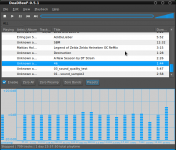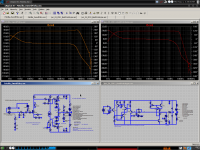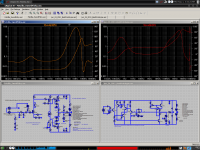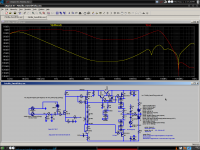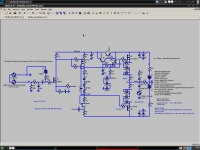Well, I just found out in a sort of unpleasant way that the gate and source are swapped on my version of the 2N5564, but nothing smoked.
Off-topic but related, when I bought my stash of 2N5551/5401, I discovered that the Y suffix means Hfe between 180-240, so I bought those. Problem is they had the C suffix too which means different pin order. So when building my Sorayas I will have to twist the pins...
- keantoken
Off-topic but related, when I bought my stash of 2N5551/5401, I discovered that the Y suffix means Hfe between 180-240, so I bought those. Problem is they had the C suffix too which means different pin order. So when building my Sorayas I will have to twist the pins...
- keantoken
2SK117 as input JFET
I have done a little tweaking on my ZVP+IRF CCS version over the weekend.
My version was a bit bass-heavy (or lack some silky treble). I replaced the input JFET (it was a 2SK170BL) with a 2SK117GR & changed R4 from 680R to 1K. The change took the musicality to another level & the amp sounds more balanced. May be the K117GR lowers the loop gain & I prefer the sound of the current version.
Cheers, Stanley
Onto,
I assume CFA is a TLA related to current feedback. If so, I learn something today.
I endorse Mike's comment; the idea was to make a singleton input stage. That means, inevitably, input on the gate and feedback on the source. If this is what you mean, then the choice was quite deliberate. It also means that the input stage has very low gain since source degeneration is necessary to accommodate the feedback network. In turn, pretty much regardless of what VAS is used, this also leads to limited open loop gain when compared to a stock bipolar input stage, and this in turn means less loop gain.
An amp with less loop gain sounds different to one with high loop gain. For starters, the distortion is much higher, and this discourages most people even before they start. But the sound quality can be very good if the distortion profile is musical.
Cheers,
Hugh
I have done a little tweaking on my ZVP+IRF CCS version over the weekend.
My version was a bit bass-heavy (or lack some silky treble). I replaced the input JFET (it was a 2SK170BL) with a 2SK117GR & changed R4 from 680R to 1K. The change took the musicality to another level & the amp sounds more balanced. May be the K117GR lowers the loop gain & I prefer the sound of the current version.
Cheers, Stanley
Attachments
https://secure.wikimedia.org/wikipedia/en/wiki/Hexspeak
I thought so too. Apparently it's "audiophile-approved". I think it is suited better for high quality audio because it uses quality-conscious codecs and plugins. It has it's own software resampler plugin so you can avoid bad soundcard and OS resampling.
I replaced the 22uF cap with a 1uF polyester. If there was a change, it isn't as big as the other issues.
I hooked up my headphone amp again. Compared to my current fetzilla it is less exaggerated and harsh in the treble and to a less degree the rest of the spectrum. The fetzilla seems to sound more detailed in some areas, but I suspect this is partly an effect of the exaggerated treble. It also seems to have odd, unsatisfying bass. I wonder if this is because of having low output impedance? Because my amp in comparison has Zout two orders of magnitude higher.
A comparison is attached for FR and Zout (Zout is often much more revealing).
- keantoken
I thought so too. Apparently it's "audiophile-approved". I think it is suited better for high quality audio because it uses quality-conscious codecs and plugins. It has it's own software resampler plugin so you can avoid bad soundcard and OS resampling.
I replaced the 22uF cap with a 1uF polyester. If there was a change, it isn't as big as the other issues.
I hooked up my headphone amp again. Compared to my current fetzilla it is less exaggerated and harsh in the treble and to a less degree the rest of the spectrum. The fetzilla seems to sound more detailed in some areas, but I suspect this is partly an effect of the exaggerated treble. It also seems to have odd, unsatisfying bass. I wonder if this is because of having low output impedance? Because my amp in comparison has Zout two orders of magnitude higher.
A comparison is attached for FR and Zout (Zout is often much more revealing).
- keantoken
Attachments
Here is a test. This file should only be unbearable at about 2:50.
http://fc02.deviantart.com/fs49/f/2009/214/9/b/Chrono_Cross___Ending_theme_by_williamsMalakiads.mp3
- keantoken
http://fc02.deviantart.com/fs49/f/2009/214/9/b/Chrono_Cross___Ending_theme_by_williamsMalakiads.mp3
- keantoken
Stanley,
Thanks for the post. The reason we went for the GR 2SK170 (NOT 2SK117) was because a jfet seems to sound best at or just under its Idss. Because of the drain source voltage, the dissipation of a BL with its 6-12mA Idss is prohibitive, so the GR version is superior. Since this device drives only the gate of the VAS with its trivial loading, lots of current is not required, so again this leans towards a lower first stage current.
In fact, many power amps with bipolar input devices seldom venture much above 2mA, so if anything the stage currents chosen, including the VAS current, are generous in this amp, leading to good slew figures.
I notice you are using only 30R VAS degen instead of the 47R recommended, any reason for that? And your source resistors on the output devices are 0.2R rather than 0.1R, does this give better quiescent stability perhaps?
Cheers,
Hugh
Thanks for the post. The reason we went for the GR 2SK170 (NOT 2SK117) was because a jfet seems to sound best at or just under its Idss. Because of the drain source voltage, the dissipation of a BL with its 6-12mA Idss is prohibitive, so the GR version is superior. Since this device drives only the gate of the VAS with its trivial loading, lots of current is not required, so again this leans towards a lower first stage current.
In fact, many power amps with bipolar input devices seldom venture much above 2mA, so if anything the stage currents chosen, including the VAS current, are generous in this amp, leading to good slew figures.
I notice you are using only 30R VAS degen instead of the 47R recommended, any reason for that? And your source resistors on the output devices are 0.2R rather than 0.1R, does this give better quiescent stability perhaps?
Cheers,
Hugh
Stanley,
Thanks for the post. The reason we went for the GR 2SK170 (NOT 2SK117) was because a jfet seems to sound best at or just under its Idss. Because of the drain source voltage, the dissipation of a BL with its 6-12mA Idss is prohibitive, so the GR version is superior. Since this device drives only the gate of the VAS with its trivial loading, lots of current is not required, so again this leans towards a lower first stage current.
In fact, many power amps with bipolar input devices seldom venture much above 2mA, so if anything the stage currents chosen, including the VAS current, are generous in this amp, leading to good slew figures.
I notice you are using only 30R VAS degen instead of the 47R recommended, any reason for that? And your source resistors on the output devices are 0.2R rather than 0.1R, does this give better quiescent stability perhaps?
Cheers,
Hugh
Hugh,
Thanks for the explanation.
I build the Fetzilla with the JFETs that I got in my parts bin - I only have K170BL & K117GR.
From what I read on DS, K117 got lower forward transfer admittance Yfs than the K170 (15mS vs 22mS). K117 is a bit noisier than K170.
I build the first version using the IRF9610 as VAS & I left the VAS degen resistor unchanged from that version.
The bias current is very stable: 88mV across the 0.2R for cold HS and again I only have 0.2R in my parts bin.
For warm HS, N-ch= 90.1mV; P-ch=90.7mV
Cheers, Stanley
Since my amp's output impedance was rather large, I am listening to the fetzilla with a similar output resistor. This had a large effect on the harshness. I wonder if this is just my speakers? The impedance of my speakers is around 33R at treble. Could this just be voicecoil inductance or possibly the impedance of air as seen by the speaker? If whatever causes the large HF impedance causes a proportional back-EMF, it could explain the positive effect of the resistor on treble.
I have read that current drive reduces a type of HF distortion. It may make sense if my speakers are worse than most in this regard, considering the large HF impedance.
The resistor doesn't remove all of the harshness. It also doesn't improve bass. I've found 1R series resistance seems to be the best value.
- keantoken
I have read that current drive reduces a type of HF distortion. It may make sense if my speakers are worse than most in this regard, considering the large HF impedance.
The resistor doesn't remove all of the harshness. It also doesn't improve bass. I've found 1R series resistance seems to be the best value.
- keantoken
It makes your FR driver droop its rise trend a bit, effecting it as a progressive L-Pad with frequency as it interacts with its rising impedance.
Which reminds, that amps don't have a sound, nor do speakers, or any other component. We can isolate components and measure them. But we can't hear them. We hear the system, which includes the room and positioning of everything in it.
Sheldon
Sheldon
keantoken
perhaps put an inductor across you 1R resistor so it only acts upon the treble ? ? ?
perhaps put an inductor across you 1R resistor so it only acts upon the treble ? ? ?
Good idea. I just tried it and it worked well. The difference itself is small but the enjoyment factor went up.
- keantoken
- keantoken
I just added this variant of my K-multiplier. Waiting for the darn thing to stabilize offset...
In simulation using a Jfet (instead of the VN0106 I have now) in the input decreases PSRR. This should allay my paranoia. Once I have the Jfet in, the bias might be more stable.
Only the rail filter part of the below schematic is accurate to my built version, no schottkeys in real life.
A friend told me the great thing about the K-multipliers was that they allowed film bypass without oscillating. For circuits where high-MHz oscillation is possible, this is probably a good thing.
- keantoken
In simulation using a Jfet (instead of the VN0106 I have now) in the input decreases PSRR. This should allay my paranoia. Once I have the Jfet in, the bias might be more stable.
Only the rail filter part of the below schematic is accurate to my built version, no schottkeys in real life.
A friend told me the great thing about the K-multipliers was that they allowed film bypass without oscillating. For circuits where high-MHz oscillation is possible, this is probably a good thing.
- keantoken
Attachments
'Understand the wisdom but regardless, we do swap out components, even whole devices and assign qualities to each type based on a perceived "sound" in a given application. The process is subjective and personal, sometimes having little to do with quantified measurements. Still, whatever we admit to, we spend a lot of time and money doing this; newbs, hacks and engineers alike, so it must have tangible merit. 🙂We can isolate components and measure them. But we can't hear them. We hear the system, which includes the room and positioning of everything in it. Sheldon
'Understand the wisdom but regardless, we do swap out components, even whole devices and assign qualities to each type based on a perceived "sound" in a given application.
Agreed. I didn't intend to discount measurements, or listening. As you say, assessments must be referenced to "a given application". A perceived issue, could be the tree (or another tree), the forest, or both.
Sheldon
KT has invented a new metric for audio.
It's up there with the GedLee metric!!
It is the 'Enjoyment Factor', known to the cognoscenti as ETF, so it won't be confused with Emitter Follower.
Thanks Kean, I like this metric a lot. It's wonderfully vague, has great relevance, and dignifies the psychoacoustic babble we audiophiles are often accused of.
Thanks!
Hugh
It's up there with the GedLee metric!!
It is the 'Enjoyment Factor', known to the cognoscenti as ETF, so it won't be confused with Emitter Follower.
Thanks Kean, I like this metric a lot. It's wonderfully vague, has great relevance, and dignifies the psychoacoustic babble we audiophiles are often accused of.
Thanks!
Hugh
- Status
- Not open for further replies.
- Home
- Amplifiers
- Solid State
- JFET input, MOSFET VAS, LATERAL output = Perfect!!
